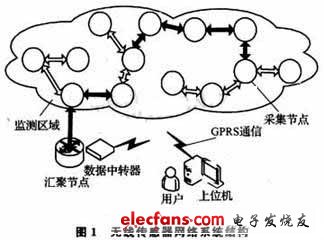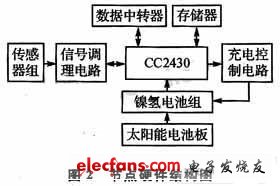introduction
Environmental monitoring is an important application area of ​​wireless sensor networks. In order to collect environmental data in a certain area, the sensor node needs to work under harsh environmental conditions for a long time without being on duty. The software design of the sensor node provides an important guarantee for the normal operation of the node.
1 Wireless sensor network system structure
The entire sensor network is composed of several acquisition nodes, 1 aggregation node, 1 data relay and 1 host computer that is convenient for users to view and control. The system structure is shown in Figure 1. The collection node is used for environmental data collection, data preprocessing, and data routing; the aggregation node is responsible for opening and maintaining the entire network, sending commands to the collection node, collecting node data, and serial communication with the data relay The data relay is responsible for data transfer and forwarding the commands of the host computer; the host computer is the terminal device for data collection, and can set the node's collection time interval, sleep time interval, and sensor switch according to user needs.

2 Hardware circuit of the node
To facilitate data collection, the hardware circuit design of the aggregation node and the acquisition node is the same, but the software design is different. Any node can be used as an aggregation node to communicate with the data relay through the serial port to collect data from other nodes in the network. The hardware structure of the node is shown in Figure 2.

The core chip selected for this design is the ZigBee chip CC2430 from TI. It uses the 8051 microprocessor as the core, and the radio frequency transceiver carried by itself is used to realize the communication of the wireless sensor network node, and provides 4-way I / O ports to control the opening and closing of the sensor. The sensor turns the corresponding environmental data into voltage, current and other signals to the signal conditioning circuit. After the relevant conditioning, it is sent to the ADC interface of the CC2430 for A / D sampling. Finally, the CC2430 stores the obtained A / D value in an external 64 Kb of memory. When the node is used as the convergence node in the network, the 2-channel I / O port of the CC2430 is set to UART0 serial ports Tx and Rx, which are used for serial communication with the data relay. For the energy supply part, in order to ensure the long-term stable operation of the node, a 2300 mA nickel-metal hydride rechargeable battery is used, and two sets of nickel-metal hydride batteries use a dual power supply mode. The software controls the switching of two sets of nickel-metal hydride batteries to realize the alternate power supply to the nodes, and controls the solar panel to charge it when the battery voltage is insufficient.
Speaker System,Magnet Speaker Acoustic,Moving Coil Loudspeaker,Metal Frame Mylar Speaker
Jiangsu Huawha Electronices Co.,Ltd , https://www.hnbuzzer.com